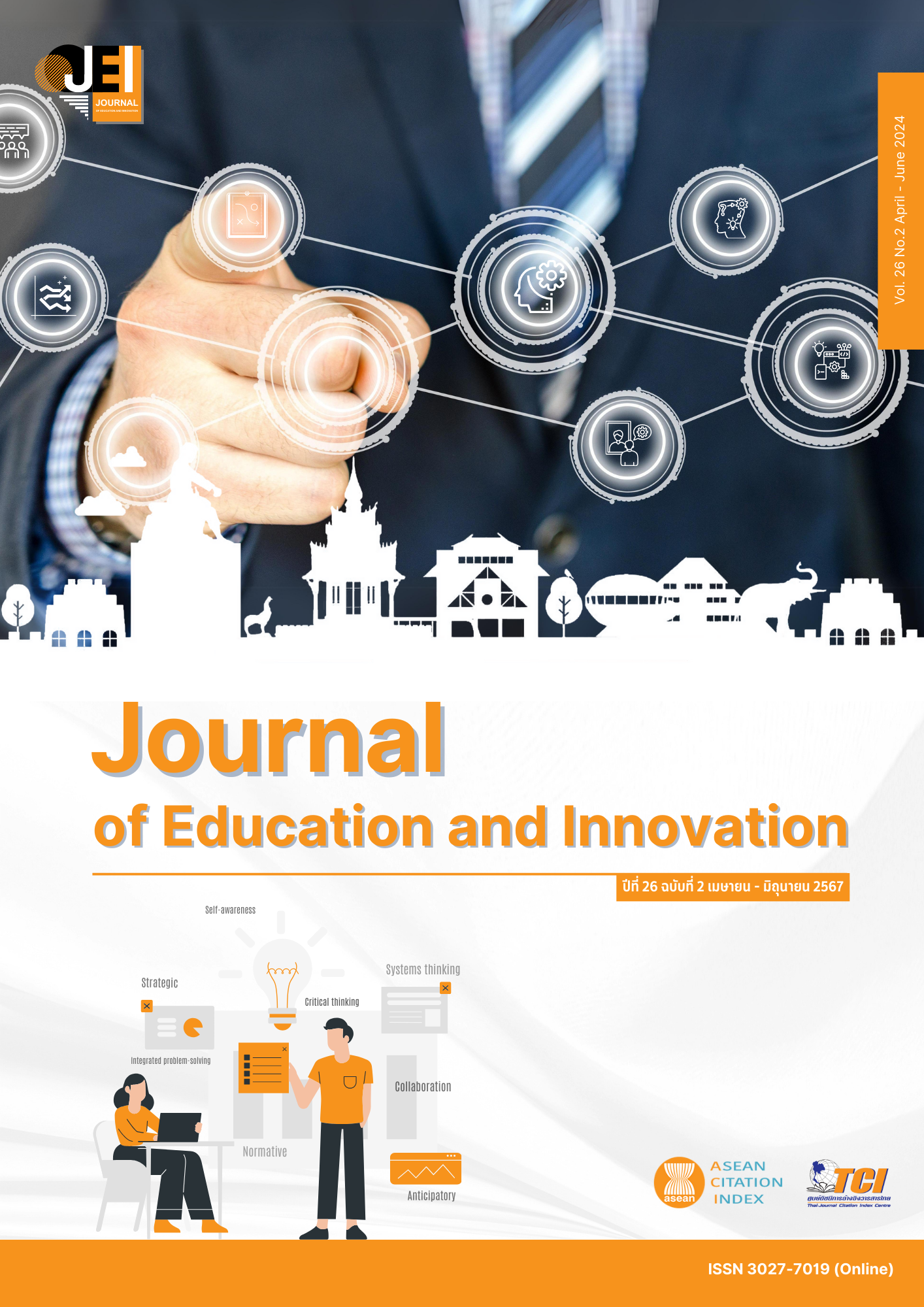THE STUDY OF CREATIVE PROBLEM-SOLVING ABILITY AFTER LEARNING THROUGH THE 3CM (COOL-CRITICAL-CREATIVE-MEANINGFUL) BLENDED LEARNING BASED MODEL ON PROBABILITY OF MATHAYOMSUKSA THREE STUDENTS
Main Article Content
Abstract
The purpose of this research was to compare the creative problem-solving ability on probability of Mathayomsuksa three students after using the 3CM (Cool-Critical-Creative-Meaningful) blended learning based model with 80 percent criteria. The population of this study were Mathayomsuksa three students at Wangchanwittaya School during the second semester of the 2022 academic year. The sample of this study were 38 Mathayomsuksa 3/2 students, who were selected by using classroom unit-based cluster random sampling. The research instruments consisted of lesson plans designed by using the 3CM model on probability of Mathayomsuksa three students and a creative problem-solving ability test on probability. Data were analyzed by using descriptive statistics, which are percentage, mean, and standard deviation, and tested the hypothesis by using One-Sample t-test. The results of the study showed that the creative problem-solving ability on probability of Mathayomsuksa three students after learning through the 3CM model was higher than 80 percent at the .05 level of significance and all students had creative problem-solving ability at “excellent” level. When consider the 4 stages of creative problem-solving ability found that 92.11 percent of the students were at “excellent” level in the problem-finding stage, 94.74 percent of the students were at “excellent” level in the idea-finding stage, 100 percent of the students were at “excellent” level in the solution-finding stage, and 100 percent of the students were at “excellent” level at the creating-knowledge stage.
Article Details

This work is licensed under a Creative Commons Attribution-NonCommercial-NoDerivatives 4.0 International License.
The owner of the article does not copy or violate any of its copyright. If any copyright infringement occurs or prosecution, in any case, the Editorial Board is not involved in all the rights to the owner of the article to be performed.
References
Boochapim, N. (2008). The development of learning outcome and analytical thinking on Thai wisdom of Matthayomsuksa two student Wathuayjawrakay Wittayakom School by inquiry-based learning (Master thesis). Nakhon Pathom: Silpakorn University.
Dale, E. (1969). Audio visual method in teaching (4th ed). New York: Holt Rinehart and Winston.
Independent Committee for Education Reform. (2019). Thai education reform mission report. Bangkok: Office of the Education Council.
Kanchanachaya, N. (2016). Creative problem-solving process instructional management. SDU Research Journal Humanities and Social Science, 12(3), 207-224.
Keereerom, N. (2021). The blended learning based on 3CM (Cool-Critical-Creative-Meaningful) model to enhance creative problem-solving ability in the topic of fraction for grade 7 students. The Golden Teak: Humanity and Social Science Journal, 28(2), 179-193.
Laowreandee, W. (2012). A study of internal supervision problems according to administrators. Nakhon Pathom: Silpakorn University.
Larasanti, R., & Prihatnani, E. (2021). Online learning with 3CM (Cool-Critical-Creative-Meaningful) and peer tutoring to improve learning outcomes and creativity. Jurnal Pendidikan dan Kebudayaan, 11(3), 271-282.
Malakul, P. (1995). Obstacles to creative problem-solving. Journal of Education, 26, 31-40.
Office of the Basic Education Commission, Ministry of Education. (2017). Indicators and core learning content mathematics department (revised version A.D. 2017) according to the basic education core curriculum A.D. 2008. Bangkok: The Agricultural Cooperative Federation of Thailand.
Office of the Education Council, Ministry of Education. (2019). Guidelines report on enhancing basic national education test results (O-NET). Nonthaburi: 21 Century.
Punpumnak, T. (2019). Learning management using SSCS model for enhance mathematics learning achievement and problem-solving skill on probability of Mathayomsuksa three students (Doctoral dissertation). Mahasarakham: Mahasarakham University.
Rizti, T. M., & Prihatnani, E. (2021). The Effectiveness of the 3CM (Cool-Critical-Creative-Meaningful) on Critical Thinking Skills of Middle School Students. Jurnal Pendidikan Matematika, 10(2), 213-224.
Sangpom, W. (2016). Lesson study on aspects of students’ mathematical thinking. Journal of Education, 27(2), 1-12.
Sornsawat, J., Kasemsukpipat, W., & Ugsonkid, S. (2018). The study of Mathayomsuksa three students’ mathematical problem-solving ability on probability after learning through SSCS Model. Mathematical Journal, 63(696), 35-51.
Sukbamrungsil, S. (2010). Motivation for the performance of Laem Chabang School of Engineering Teachers Chonburi (Master thesis). Chonburi: Burapha University.
Supapimonwan, S. (2020). Development of mathematics instructional model base on constructivism for developing creative problem-solving ability of eighth grade students (Doctoral dissertation). Chonburi: Burapha University.
Thaithani, P. (2019). Promoting intrinsic motivation among learners. Ratchaphruek Journal, 18(1), 9-19.
Wahyudi, Waluya, S. B., Suyitno, H., & Isnarto. (2019). Development of 3CM (cool-critical-creative-meaningful) learning model to increase creative thinking skill. Journal of Physics: Conference Series, 5(1), 1-9.
Wahyudi, Waluya, S. B., Suyitno, H., & Isnarto. (2019). The use of 3CM (Cool-Critical-Creative-Meaningful) model in blended learning to improve creative thinking ability in solving mathematics problem. Journal of Educational Science and Technology, 5(1), 26-38.
Yodyom, N. (2019). A study of mathematics achievement on probability using the problem-solving process of Polya for students grade 9 (Research report). Phitsanulok: Pibulsongkram Rajabhat University.


